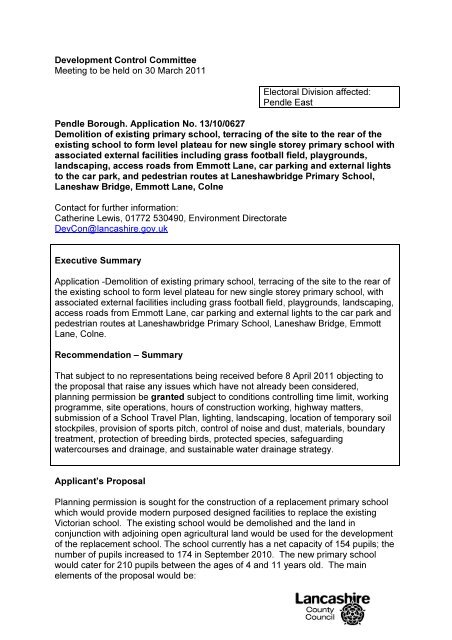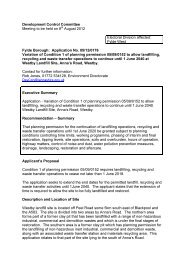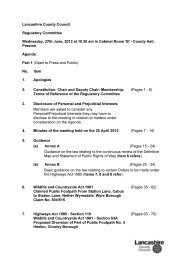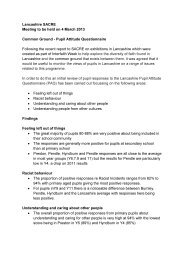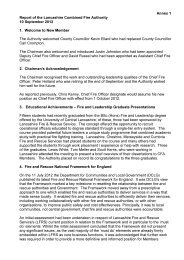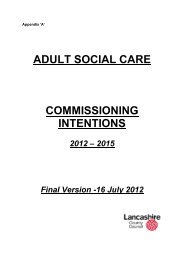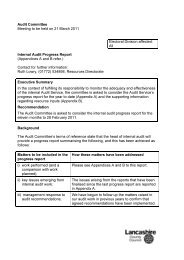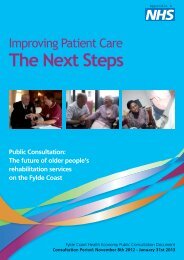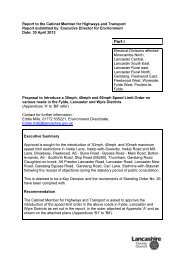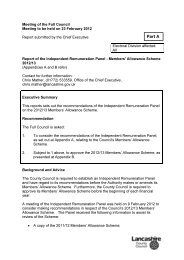Laneshawbridge Primary School, item 8. PDF 223 KB - Lancashire ...
Laneshawbridge Primary School, item 8. PDF 223 KB - Lancashire ...
Laneshawbridge Primary School, item 8. PDF 223 KB - Lancashire ...
Create successful ePaper yourself
Turn your PDF publications into a flip-book with our unique Google optimized e-Paper software.
Development Control CommitteeMeeting to be held on 30 March 2011Electoral Division affected:Pendle EastPendle Borough. Application No. 13/10/0627Demolition of existing primary school, terracing of the site to the rear of theexisting school to form level plateau for new single storey primary school withassociated external facilities including grass football field, playgrounds,landscaping, access roads from Emmott Lane, car parking and external lightsto the car park, and pedestrian routes at <strong>Laneshawbridge</strong> <strong>Primary</strong> <strong>School</strong>,Laneshaw Bridge, Emmott Lane, ColneContact for further information:Catherine Lewis, 01772 530490, Environment DirectorateDevCon@lancashire.gov.ukExecutive SummaryApplication -Demolition of existing primary school, terracing of the site to the rear ofthe existing school to form level plateau for new single storey primary school, withassociated external facilities including grass football field, playgrounds, landscaping,access roads from Emmott Lane, car parking and external lights to the car park andpedestrian routes at <strong>Laneshawbridge</strong> <strong>Primary</strong> <strong>School</strong>, Laneshaw Bridge, EmmottLane, Colne.Recommendation – SummaryThat subject to no representations being received before 8 April 2011 objecting tothe proposal that raise any issues which have not already been considered,planning permission be granted subject to conditions controlling time limit, workingprogramme, site operations, hours of construction working, highway matters,submission of a <strong>School</strong> Travel Plan, lighting, landscaping, location of temporary soilstockpiles, provision of sports pitch, control of noise and dust, materials, boundarytreatment, protection of breeding birds, protected species, safeguardingwatercourses and drainage, and sustainable water drainage strategy.Applicant’s ProposalPlanning permission is sought for the construction of a replacement primary schoolwhich would provide modern purposed designed facilities to replace the existingVictorian school. The existing school would be demolished and the land inconjunction with adjoining open agricultural land would be used for the developmentof the replacement school. The school currently has a net capacity of 154 pupils; thenumber of pupils increased to 174 in September 2010. The new primary schoolwould cater for 210 pupils between the ages of 4 and 11 years old. The mainelements of the proposal would be:
• A single storey building incorporating a sports hall with a maximum roof heightof 6.5 metres. The building would be rectangular in shape and constructed ofnatural stone and areas of coloured render.• A green sedum roof.• Outdoor facilities would include foundation, infant and junior playgrounds withadditional external teaching spaces directly accessed from each playground.• A sports playing field would be provided to the north of the school building.• Two terraced grassed banks would be formed through cut and fill earthworksoperations to provide corresponding areas of level ground for a playing fieldand for the main school building. One terrace would be formed to the rear ofthe proposed school building and would include a ramp up the playing fieldwhile the second terrace would be located on the southern boundary betweenthe rear gardens of the properties on Kingsley Road and the school site.• Landscaping works including nature study area, outdoor classroom spaces,parent waiting area with benches, trim trail and associated equipment and regradingworks.• Dedicated car parking will be provided for staff including the provision of 2designated disabled spaces.• A new vehicular access would be constructed on the existing school siteincorporating a one way system, pupil drop off zones, 16 car parking spacesand erection of associated lighting.• 16 four metres high lighting columns to the car park, access road andpedestrian routes together with wall mounted lighting against the side of thebuilding.• An additional service road would be created from Emmott Lane for deliveriesand emergency vehicles only.• Realignment of Public Footpath No.105, which currently traverses part of thenorthern boundary of the site running east to west.• A 1.2 metre high post and rail timber fence would be constructed on the outerfield boundary and 1.5 metre high bow top metal railings and gates wouldenclose the playgrounds.Description and Location of SiteThe application site occupies an area of approximately 2.1 ha located to the west ofEmmott Lane approximately 0.5 km from the centre of the hamlet of LaneshawBridge. The majority of the site comprises agricultural grazing land with a fall ofapproximately 14 metres from north to south with an undulating surface. PublicFootpath number 105 runs from Emmott Lane through the northern part of the site ina westerly direction. There are residential properties which back on to the site on thesouthern and eastern boundaries.The main vehicular and pedestrian access would be from Emmott Lane utilising theexisting school site. A further vehicular access for deliveries and emergencies onlywould be created opposite 58 Emmott Lane, a residential property.The majority of the application site falls outside the settlement boundary on land thatis allocated in the Replacement Pendle Local Plan as open countryside. The
existing school site, which forms part of the application site, is within the settlementboundary and a small part of the site is allocated as Public Open space.BackgroundThe Development Control Committee resolved to visit the site at the meeting of 5January 2011; Members of the committee visited the site on the 23 March 2011.Planning permission was granted for a single storey demountable classroom on 28January 2010 (ref 13/09/0496).Planning PolicyPlanning Policy Statement 1: Delivering Sustainable DevelopmentPlanning Policy Statement 7: Sustainable Development in Rural AreasRegional Spatial StrategyPolicy RDF 2 Rural AreasReplacement Pendle Local Plan (RPLP)Policy 1 Development in the Open CountrysidePolicy 7 Water Resource ProtectionPolicy 13 Quality and Design of New DevelopmentPolicy 14 Trees Woodland and HedgerowsPolicy 16 Landscaping in New DevelopmentPolicy 25 Location of Service and Retail DevelopmentPolicy 28 Retail and Service provision in VillagesPolicy 29 Creating an Improved Transport NetworkPolicy 30 Sustainable Travel ModesPolicy 31 ParkingPolicy 32 New Community FacilitiesPolicy 33 Existing Open SpaceSupplementary Planning Guidance Development in the Open Countryside 2002(PBC)ConsultationsPendle Borough Council - Object to the proposal for the following summarisedreasons:• The new school would be developed on a Greenfield site outside of theadopted settlement boundary. The council does not consider that clear andexceptional circumstances have been demonstrated to justify the provision ofcommunity facilities outside the settlement boundary. It is therefore contraryto Policy 32 of the Pendle Local Plan.
• The size of the site and proposed location have not been sufficiently justified(it would appear that 75% of pupils live outside of the catchment area).Opportunities to extend or alter the configuration need to be explored.• Community facilities require development to be accessible by a variety oftransport modes. The majority of pupils appear to live outside the community.• Policy 28 requires the 'applicant to provide evidence of need and must showmeasurable public support'. It is considered that the scheme is not supportedby the majority of local people.• The proposal would have a detrimental impact upon residential amenity.• No transport assessment has been submitted.Laneshaw Bridge Parish Council - Object for the following summarised reasons:• Access is only available by car.• There is no provision for access on foot from Emmott Lane.• The proposal is contrary to Policy 2<strong>8.</strong> The consultation with local people hasbeen desultory and half hearted.• Barriers have been put in the way to preclude Council consultation.• Site selection evidence has not been publicised. The Emmott Lane site is notsuitable.• No evidence of a highway survey, or consideration of the dangerous crossroads where Emmott Lane meets the A606<strong>8.</strong>Public Realm Area Manager - No objection. The manager has sought confirmationas to how the emergency and delivery access would be controlled as there are nogates shown. Public Footpath no.105 to be diverted should be shown on the plans.Section 106 monies should be required to improve the Public Footpath No 213. Apedestrian crossing is required near to the junction with Emmott Lane. Shouldpermission be granted conditions are recommended requiring:• Visibility splays on both the new entrances to be be marked on the drawing.• The gates at the access to the pupil drop off should be set back by a minimumof 5 metres.• A Travel Plan should be required.• Wheel cleaning measures should be employed.• The existing access to be closed and kerb way to be reinstated.• A scheme for construction traffic to be agreed.• All highway works to be completed before school opens.LCC Specialist Advisory Services Ecology - No objection subject to conditions toensure the protection of trees during construction; protection of nests during thebreeding season; further bat survey required if works not carried out in a year; andprotection of bats if found during demolition.LCC Specialist Services Archaeology- No objection.United Utilities – No observations received.Sport England - No objection.
Ramblers Association - No objection but would not wish any diverted footpath tohave high fencing to both sides.Environment Agency- No objection but any works to the watercourses require theprior written consent of the Environment Agency.Representations – The application has been advertised by press and site notice, andneighbouring residents informed by individual letter. The representations receivedare reported and summarised as letters in support and opposing the proposal. Theissues raised in the representations have been grouped under common headings asfollows:Representations in Support of the Proposal222 individuals have written in support of the proposal. The Head of the school hasalso written in support of the proposal along with 142 letters from pupils of the schoolsimilarly in support of the proposal.The reasons for supporting the proposal are summarised as follows:Policy Reasons• The school believes that there are clear and exceptional circumstances asrequired by Policy 32 of the Local Plan.• They have a genuine academic excellence (Beacon <strong>School</strong> status in 2001,Outstanding Ofsted reports 1998, 2003, and 2008 and 8 th in Sunday Timesleague table for <strong>Primary</strong> <strong>School</strong> education last year, Highest performingprimary school in <strong>Lancashire</strong> on basis of schools performance in the SATSleague tables).• Highest standards of social development and pastoral care.• Extraordinary demand for places (175 number on roll 21 over the capacity ofthe building; Governors recently agreed to LCC’s request to the admissionnumber being increased to 30 from September 2012. Policy decision alreadybeen made by LCC to expand the school one-form entry).• The school is a village facility and as such only Policy 28 is relevant. This setsout that where there is over demand on existing facilities a new build shouldbe within the settlement boundary and will only be acceptable outside avillage boundary where the applicant can provide evidence of need and hasconsulted the local village people gained support for both the proposed useand intended site.Access and traffic• The traffic on Emmott Lane is bad at drop off and collection times - the currentapplication would seek to address these difficulties. Staff cars would have adedicated car space and therefore more on street parking for local residents.• Variety of transport modes available to access the school - already a walk toschool scheme, same bus routes available as at present. Travel Plan shows atarget to increase walking, cycling and car sharing.
Other sites• LCC undertook an option appraisal and considered three sites: the currentapplication, expansion on the existing site (too small and would lead to loss ofvillage playing area) and a further site, the Emmott Trust field (landownershipissues). The demand for places is evidence of need, 37% of pupils live within1 mile, 65% within 2 and 90% within 3. As the school is in a rural locationsome pupils access the school from more than 2 miles as this would still bethe closest school available.• The ‘Welcome to Laneshaw Bridge’ sign is 2.5 miles away from the school.Other issues• Extensive Public Consultation has taken place; a meeting was held 17September 2009 and 9 September 2010. Laneshaw Bridge Parish Councildiscussed the expansion of the school with an LCC Officer. Open day sessionOctober 21 and 22 2010 and plans were available for public to see.• <strong>School</strong> has received over 400 letters of local support - clear evidence ofmeasurable support.• The proposals envisage a significant degree of Community Use by the villageand will allow for more community use. Therefore meets the requirement ofPolicy 2<strong>8.</strong>1 which states that support will be given for a proposal that willprovide for joint use of an existing facility.Existing <strong>School</strong> Building• Inappropriate for children’s education• No outdoor provision for the Foundation stage• Severe risks to Health and safety due to limited /overcrowded accommodation• Only negative comment on any Ofsted report relates to cramped conditions• Lack of school kitchen and an appropriate sized Hall means children eat theirpacked lunch at their desks• Whole school productions have to take place at the local theatre due to size ofHall. Smaller productions have meant parents standing in the playground andlook through the windows.• Mobile classroom required and this has limited size of playground.• Toilet and cloakroom facilities are outdated and confined.New Facilities• Would provide a modern 21st Century school one form entry with improvedSporting facilities, play areas ICT, kitchen and toilet facilities.• In order to maintain exceptionally high standards improved facilities required.• The scheme provides an opportunity to address current traffic problems withimproved parking and access.Representations Opposing the Proposal
210 individuals have made written objections to the proposal. A petition of 488signatories has been received similarly objecting to the proposal (some of thesignatories are addressed from Laneshaw Bridge, some from outside LaneshawBridge and some are not addressed at all. The reasons for objecting to the proposalare similarly set out under a number of headings and are summarised as follows:Planning Policy• The development is contrary to the following policies and planning guidance: Planning Policy Statement 7 sustainable development in rural areasseeksto protect and where possible enhance the quality and characterof the wider countryside. Planning Policy Guidance 13 - Support more sustainable key transportchoices. Pendle Borough Council's Supplementary Planning guidanceDevelopment in the Open Country Side 2002 –new development inopen country side should be limited in scale to modest schemes whichmakes a positive contribution to landscape character. The site is not identified on the Proposals Map of the Local Plan and iscontrary to Policy 12 which restricts the development of land whichcontributes to the openness, character, and local amenity of asettlement. The only policy that supports this application is Policy 1.• The development equates to 14% of the total village settlement and isapproximately 12 times the size of the existing school Therefore it cannot bedescribed as small scale development to meet a demonstrable need as setout in Policy 28 and referred to in Policy 32.• The proposal seeks to increase the pupil capacity by 25% and is therefore notsmall scale.• Consultation process carried out by LCC flawed. The initial consultationreferred to expansion of school places and not a completely new developmenton a new site involving demolition of the existing school. Had LCC beenexplicit in their true intentions there would have been significant opposition atan early stage. Support for the proposal is skewed by the fact that 75% ofpupils are from outside the area.• Appropriate consultation for the proposal and chosen site as set out by Policy2<strong>8.</strong>2 has not been fulfilled.• Project of this scale is outrageous will not benefit this small rural community.• Existing building suitable to satisfy the needs of village children.Education Policy• The applicant suggests that parents have a right to choose which school achild attends but this is not the case. Actual education policy is based onpreference not a right.• There are a total of 1,112 surplus places in the area from whichLanshawbridge <strong>School</strong> draws its pupil numbers. As there are significantnumbers of surplus places under no definition can this be defined as need.
• In a document prepared on the 4 March 2009 to the Cabinet Member of<strong>School</strong>s - an application for funding, it stated ‘There is no basic need foradditional places in the area’ this paper discusses options including a site onthe opposite side of Emmott Road and highlights the new build as problematicdue to planning constraints and community/residents views. Why is thecurrent application any different?• The proposal does not satisfy the aims of the document entitled ‘Expanding aMaintained Main Stream <strong>School</strong> by Enlargement or Adding a 6 th Form’(DCSF) updated Feb 10. This document sets out the guidance for schoolsapplying to expand. It should not be taken as a right to override any land usepolicy and planning guidance. In particular-The planned enlargement of the school will divert funds away fromother schools and could have an adverse impact upon disadvantagedgroups.The proposal should not have the effect of unreasonably extendingjourney times. 75% of pupils travel from outside the village, 87% travelby car or taxi and no pupils travel by bus. Many who live in the villagedo not walk to school because it is viewed as too dangerous.The document does not say that additional capacity in other schoolsshould be ignored. The applicant is confusing need with parentalpreference. The magnitude of surplus places cannot be legitimatelyignored.• Other schools manage their appeals process in a more robust way. Thegrounds for appeals being lost in other schools are to do with capacity of theschool, health and safety. These are the arguments that the school is makingin support of their case.Access, traffic and Amenity• Transport Assessment and Travel plan is required as stated in Policy 29• Emmott Lane is a single track road which links to the main infrastructure atextremely blind dangerous corners. Expansion of the school by 50 places willmake the situation significantly worse.• Concerns have been raised regarding the Singleton Clamp and PartnersTransport Statement which is seen as too superficial and contains seriesflaws.• The report makes no measure or comments on significant traffic movementson Kingsley and Sheridan Roads in terms of parking and dropping off pointsfor parents.• Concern is raised regarding emergency vehicles accessing Emmott Lane.• Due to narrowness of the road concern regarding the second northernentrance to be used for construction traffic and then by service andemergency vehicles is raised.• The road infrastructure is already at capacity and therefore this restricts pupilsand staff from accessing the school by foot or by cycle.• Any increase would be detrimental to the residential amenity of residents andwould create significant safety and congestion issues. The proposed turningarea and drop off area would not alleviate the parking and congestion
problems and the provision of visibility splays would remove existing on streetparking spaces used by the residents.• The proposal would generate unacceptable levels of light pollution.• The proposal would lead to loss of residential amenity due to noise anddisturbance attributable to the proximity of the school building and associatedplay facilities.Some representations recommend that if planning permission is to be granted thenthe existing school stone boundary wall to the frontage of Emmott Lane should beretained and that there should be no pedestrian access to the rear of 63 EmmottLane.AdviceDirector of Environment and Public Protection Services – ObservationsPlanning permission is sought for the construction of a replacement primary schoolon land to the west of Emmott Lane and to the rear of the housing on SheridanRoad. The majority of the site falls outside the defined settlement boundary on landidentified as Open Countryside in the Replacement Pendle Local Plan (RPLP); anarea to the south (currently occupied by the existing school) falls within thesettlement boundary.The main issues to be considered when assessing the proposal are:• The principle of the development and compliance with development planpolicies.• The implications of the development on the road network in terms of trafficand safety.• Design and visual impact.• Impacts on the amenities of neighbouring and nearby residential properties.• Ecology.• Other issues.These issues are addressed as follows.The Principle of the DevelopmentThe proposed development is for the re-contouring of land to facilitate theconstruction of a new replacement primary school building, playing field, an internalaccess road, car park spaces, two dedicated play areas, an outdoor classroom,associated fencing, nature study area, and a separate access from Emmott Lane forservice and emergency deliveries. These elements would be located within the opencountryside as defined in the RPLP.A new vehicular access from Emmott Road, together with a dedicated car park to beused as staff car parking with pupil drop off zone and several spaces for parentswould be constructed on the existing school site. 1.5 metres high railings would beerected on the eastern boundary of the site frontage to Emmott Lane. Theseelements fall within the settlement boundary as defined in the RPLP.
The application must be assessed and tested against the relevant national, regionaland local policies for development within the urban area and open countryside.Section 38 (6) of the Planning and Compulsory Purchase Act 2004 provides thatplanning applications must be determined in accordance with the development planunless material planning considerations indicate otherwise.The relevant development plan policies for open countryside are Policy RDF2 of theNorth West of England Regional Spatial Strategy (RSS) and Policy 1 of the RPLPwhich reflect the principles set out in the Government guidance in Planning PolicyStatement 1: Delivering Sustainable Development and Planning Policy Statement 7:Sustainable Development in Rural Areas. These policies seek to limit newdevelopment within the open countryside and to concentrate new developmentwithin defined settlement/urban boundaries. However, Policy 1.1(8) of the RPLPstates that proposals for development outside a defined settlement will only bepermitted in certain circumstances including development for education/ communityuse. The principle of a new school outside the defined settlement boundary maytherefore be considered acceptable for the purposes of policy 1.1(8) of the RPLP.However, as the majority of the proposed development falls outside the definedsettlement boundary and the site is not identified for new community facilities in thelocal plan, the proposal must be considered against policies 32 and 28 of the RPLP.Policy 32 sets out the criteria for assessing new community facilities and requiresthere to be exceptional circumstances if new community facilities are proposedoutside the settlement boundary. The policy states that planning permission for newand improved community facilities will be supported but proposals for new facilitiesmust be compliant with the following:• Be located within a defined settlement boundary, unless there are exceptionalcircumstances to permit development beyond a boundary or the proposal isfor a village (Policy 28) or tourist facility (Policy 40).• Be accessible by a variety of travel modes (Policy 30).• Not compromise residential amenity.• Be of high quality design and adhere to Policy 13.The supporting text states:'In exceptional circumstances new community facilities may be permittedoutside a settlement boundary. Only where it can be shown that no alternativesite exists in the town of the proposal, will new facilities for community benefitbe considered on sites beyond a settlement boundary. In villages there mustbe a proven ‘need’ (Policy 28 – retail and service provision) for developmentbeyond the settlement boundary. In cases where development is permittedbeyond a settlement boundary, only the community facility will be permitted onthe site. New development should be designed so as to be inclusive of allthose in the community, with good accessibility and sufficient parking for allmodes of transport, without compromising road safety.
Policy 28 of the Local Plan states that proposals to introduce new facilities to villageswill only be supported where the proposal is small scale to meet a demonstrableneed. Additionally, it must be demonstrated that there are no suitable sites withinthe settlement boundary; the policy states:'In such instances the applicant must provide evidence of need and mustshow measurable public support through appropriate consultation with localpeople, both for the proposed facility and the chosen site.'The supporting text states:' Any new building should be within the settlement boundary and will only beacceptable outside a village boundary where the applicant can provideevidence of need (as above) and where the applicant has consulted localvillage people and gained support for both the proposed use and intendedsite.'The Policy seeks to control the introduction of new shops and services in villages.However, the application relates to a replacement school and community facilityalbeit on a larger footprint and therefore the principle of the need for a school withinthe village is not in question. The issue is whether or not there is demonstrable needfor a larger replacement school on land predominantly outside the settlementboundary.The applicant has advised that a detailed options appraisal in relation to theexpansion of the school has been undertaken. A number of sites have beenconsidered including:• The redevelopment of the existing school site and adjoining land, in LCCownership and partly leased to Pendle BC.• The development of land to the east of Emmott Lane.• The development of land to the west of Emmott Lane.The preferred option in land use planning terms would be the re-development of theexisting site as this and adjoining land is wholly within the village settlementboundary identified in the local plan. Such development would meet the criteria setout in Policy 32. However, the applicant’s assessment of this option concluded thatthis site was too small, would cause more traffic problems due to the loss of onstreetparking and would not be able to provide the necessary outdoor recreationfacilities needed for the delivery of the modern education curriculum. Further, thisoption would require the use and removal of the community playground which issubject to a lease with Pendle Council thus removing a valued community facility.This option was therefore discounted.The second option was to develop the land to the east of Emmott Lane, north of theschool site. However, the development of this site was discounted primarily due toland availability and the difficulties of acquisition if it could be demonstrated thatthere are other options available. The third option is the site the subject of thecurrent planning application.
<strong>Laneshawbridge</strong> <strong>Primary</strong> <strong>School</strong> is a popular and successful school. It currently hasa net capacity of 154 pupils; the number of pupils increased to 174 in September2010. The replacement school has been designed to cater for 210 pupils betweenthe ages of 4 and 11 years thereby providing a one form entry. The replacementschool site would be larger than existing but much of which would be playing fields,landscaped areas, and external educational play areas, facilities that the currentschool does not enjoy.The replacement school would provide the opportunity for a one form entry wherechildren would be taught with their peers rather than in mixed age classes. Theschool was awarded Beacon Status in 2001 when the school was funded to spreadgood practice to other schools. Three major Ofsted inspections in 1998, 2003 and2008 all found the school to be ‘Outstanding’; the school was recently listed 8 th onthe Sunday Times list of top 500 primary schools out of a possible 28,500.Additional supporting information submitted by the applicant states that the fabric ofthe present building is inappropriate for the children's education despite thestandards that have been achieved.• The existing school was built in 1912 and suffers from poor and unsuitableaccommodation.• There is no outdoor provision for the Foundation Stage which is a statutoryrequirement.• The limited accommodation in general presents severe risks to Health andSafety.• There is no school kitchen - due to changes in health and safety legislationthe original facility was no longer fit for purposes. The school arranged formeals to be brought in from other schools but the meals were too cold. Nowpacked lunches are the only option which children eat at their desks due tothe lack of appropriate hall facilities.• PE and games have to be taught in half classes because of space restrictionswhich cause problems with staff resources.• The mobile classroom installed on the play ground to cater for needs ofschool has resulted in a reduction in playground space causing moreincidents.• Toilet and cloakroom facilities are out-dated.• The school hall at 66m 2 is barely a corridor compared with DfE guidelines of160m 2 . This causes accommodation and safety issues.• A mezzanine classroom built as a group room now has to be used as a YearOne classroom which is extremely cramped and provides a major Health andsafety hazard.Concern has been expressed by objectors that the school is a victim of its ownsuccess and that the need for a new school is based on parental choice with manyfamilies choosing to travel to this school when other schools in closer proximity havesurplus places.It is maintained that there are 1,112 surplus places in the area from which<strong>Laneshawbridge</strong> <strong>Primary</strong> <strong>School</strong> draws its pupil numbers; that the applicant isconfusing need with parental preference; there is no real need for a new school
facility of this size; the present school is capable of providing full facilities for thecorrect number of pupils able to be accommodated by the capacity of the building.The applicant has advised that demand for primary school places in rural Pendle andPendle as a whole is growing. This project has been successful in securing £1.5mas part of a Targeted Capital Fund programme. The main criteria for this fundingwas to give more children the opportunity to experience excellent education atsuccessful and Beacon schools.Government guidance (set out in a DCSF document entitled - Expanding aMaintained Mainstream <strong>School</strong> by Enlargement or Adding a Sixth Form - A Guide forLocal Authorities and Governing Bodies) is clear that popular and successful schoolsshould be encouraged to expand. Furthermore, the existence of surplus capacity inneighbouring less popular or successful schools should not in itself prevent theaddition of new places.The applicant has advised that a catchment area system for admission to primaryschools is not employed in <strong>Lancashire</strong>. Central Government places a duty on localauthorities to provide for parental choice in accordance with the Education andInspectors Act 2006. Supporting information to the application states that 65% ofchildren live within a 2 mile radius and 90% live within 3 miles. The opportunity ofchoice by parents for child education is not constrained by land use planningsettlement boundaries. Consequently there is potentially a conflict betweennationally education provision and the freedom of choice for education and the landuse planning process of supporting developments outside defined settlementboundaries.It is therefore necessary to consider whether the proposal can be supported in lightof the local plan policies and what weight should be attached to meeting governmentpolicy on freedom of choice for education.Concern has also been expressed by the Parish Council, Pendle Borough Counciland objectors that the applicant has failed to show measurable public supportthrough appropriate consultation with local people, both for the proposed facility andthe chosen site as required by Policy 28 .2.The applicant has advised that officers attended a Parish Council meeting on the 17September 2009 relating to a proposal to extend the existing school and discussionensued upon the potential sites for a new school building should the decision betaken to increase the school size. A further update was provided to the ParishCouncil at their meeting of 9 March 2010 where consultation questionnaires werehanded out. That meeting was convened by the Parish Council and attended by over60 people; the applicant has advised the majority of those attending were against thebuilding of a new school. The applicant has also advised that concerns were raisedrelating to: perceived lack of consultation; traffic issues on Emmott Lane; and theincrease in the number of pupils attending from outside the village. Following themeeting a petition in favour of the new school was received, signed by 70 people. Onthe 21 and 22 of October the applicant held two open consultation sessions in theschool in advance of the submission of the current planning application.
Planning Policy Statement 1 states that'Planning decisions should be taken in accordance with the development planunless other material considerations indicate otherwise. Planning decisionstaken in accordance with the plan are therefore key to the delivery ofsustainable development. In some circumstances, a planning authority maydecide in reaching a decision to give different weight to social, environmental,resource or economic considerations. Where this is the case, the reasons fordoing so should be explicit and the consequences considered.'It is accepted that the majority of the built form (school building, car parking spacesand playground) of the school development does not fall within the settlementboundary and therefore does not accord with the general principle of restrictingdevelopment within the open countryside. However Policy 1 .1 (8) of the RPLP doessupport development within the open countryside for education /community use.Furthermore, PPS7 states that 'Priority should be given to the re-use of previouslydeveloped(‘brownfield’) sites in preference to the development of greenfield sites,except in cases where there are no brownfield sites available. The applicant hasprovided information to support the proposed development in this location and it isconsidered that there is demonstrable local need following appropriate consultationwith local people. Although there has been opposition to the proposal there has alsobeen public support; the arguments for and against the proposal are therefore finelybalanced.PPS1 allows for exceptional circumstances to override land use issues if othermaterial considerations indicate otherwise. The school is not a new facility but areplacement building to provide a one form entry with modern facilities. It would alsoprovide the opportunity to deliver modern standards of education in a similar way tothat already provided but with the benefit of purpose designed improved andextended facilities including appropriate classroom sizes, hall, food services, toiletsand the provision of external play facilities and associated car parking and vehiclecirculation space. Notwithstanding the replacement school would provide for anincrease in pupil numbers, some of which would probably live outside the definedsettlement boundary, but the county council does not have a catchment policy andmust have regard to national guidance relating to freedom of choice for education. Itis considered that these are material considerations that warrant support for theproposal in principle.For the purposes of policy 28, it is accepted that the replacement school site isconsiderably larger than the present site. This is to provide for a development withina sloping site and provide a building and external play facilities, landscaping, carparking and vehicle manoeuvring areas to modern educational standards over andabove the sub standard facilities the existing school suffers from. Policy 28 supportssmall scale development to meet a demonstrable need; it is considered that whilstthe proposed replacement school site is considerably larger than the existing site,this is attributable to the need to deliver those facilities required of a modern schooland which, due to the historic nature of the existing school, are not available. It isconsidered that the applicant has demonstrated a need for improved educationfacilities and that to provision cannot be made within the existing settlement
oundary. Due to the physical constraints and availability of surrounding land, theproposed site is considered to be the preferred option.The option of refurbishing and extending the existing school within the settlementboundary could not deliver the same opportunities afforded by the proposedreplacement school and associated facilities even if there were to be a catchmentpolicy or a restriction on the origin of pupils who attend the school and a need for it toonly serve the local community. It is therefore considered that on balance theproposal accords with policy 32 and 28 of the RPLP.It is therefore concluded that the principle of a replacement school is in accordancewithin policy 1.1(8) of the RPLP. For the purposes of policy 32 it is considered thatthe existing school facilities are sub standard in terms of accommodation and playingarea provision, there are no alternative sites that could accommodate a replacementschool within the settlement boundary, that there is a proven need which isdetermined by central government policy for freedom of choice of education, whichtogether are considered to be exceptional circumstances to support the developmentof a replacement school outside the settlement boundary. Matters relating to accessand traffic and design for the purposes of this policy are addressed below.Irrespective of the acceptability of a replacement school being developed in opencountryside, it is still necessary to consider the impacts of the proposal in the localenvironment. These are considered below.Traffic and safetyConcerns have been expressed with regard to the existing traffic issues associatedwith the primary school and that a traffic assessment was not initially undertaken.The concerns relate to safety, risk of accidents and the capacity of the local highwaynetwork to accommodate any increase in vehicular movements associated with areplacement and an increase in school capacity.A Transport Assessment has subsequently been carried out and submitted insupport of the application. The assessment concludes that the addition of a further36 pupils and 4 staff would add up to approximately 24 vehicle movements ontoEmmott Lane at the busiest periods i.e. drop off and pick up times. The assessmentconsidered that this level of additional traffic would not materially affect the operationof the junction of Emmott Lane/ Keighley Road. The assessment considers that theintroduction of new facilities such as cycle parking in combination with the continuingTravel Plan would contribute to reducing the dependence on use of the private car.Two means of vehicular access to the site are proposed; one to the northern part ofthe site opposite no 58 Emmott Lane for service and emergency vehicles; and themain access to the school for staff and pupils, 18 metres south of the existing schoolbuilding. This would be the main entrance to the school; a total of 25 parking spaceswould be provided on site; nine of these would be located next to the school buildingon the upper section of the site one of which would be dedicated for mobilityimpaired and 16 on the lower front site at the entrance, two of which would bededicated for the mobility impaired. Ten cycle spaces would be located next to themain entrance to the building. The lower car park area would incorporate a space to
drop off children away from Emmott Lane thereby contributing to reducing trafficcongestion at picking up and dropping off times.Due to the nature of Emmott Lane it is evident that there are problems associatedwith school traffic involving school staff parking and dropping off and picking childrenup due to the lack of on-site parking facilities and vehicle manoeuvring space,particularly at the beginning and end of the school day. These issues are notdissimilar to what is experienced at many schools at these times. It is consideredthat whilst there would be an increase in the overall number of pupils at the proposedreplacement school, the proposed parking arrangements would contribute toalleviating some of these problems by providing on site parking and off highway dropoff/pick up facilities. The County Council's Manager of Public Realm has notobjected to the proposal but has recommended conditions be imposed in respect ofvisibility splays, securing of the emergency access, wheel cleaning measures to beemployed during demolition and construction phases, details for the re-instatementof the existing access and kerb, and all highway works to be completed before theschool is opened. A pedestrian crossing facility across Keighley Road is alsorecommended. The Manager of Public Realm requirements could be achieved byconditions and through a highway agreement.Revised plans have been submitted including details of the proposed footway fromEmmott Lane to the car park area and to the access point into the school site. A 2.5metre wide planted landscaping strip has also been incorporated to the rear ofproperties on Kingsley Road which would contribute to reducing the visual impact ofusers of the path and of the car parking area on the amenities of adjoining residentialproperties.The Manager Public Realm has also requested improvements to a section of PublicFootpath No 213 which runs from Keighley Road to the school site via the public playground to the south of the existing school site and which is used as an access to theschool. The footpath crosses the existing public play area which is grassed.Improvements are only requested for the section of path between Keighley Road andthe beginning of the grassed play area. Improvements to this section of the path arenot considered necessary for the purposes of this application given that it would stillnecessitate crossing the grassed public play area to access the school and it shouldbe a matter for the Manager of Public Realm to maintain the surface of the path ifconsidered necessary.The <strong>School</strong> has had a Travel Plan in place since 2006 and has a number of ongoingtargets. The Travel Plan encourages alternative means of transport to access theschool. However, due to the location of the existing and proposed replacementschool alternative sustainable transport options are limited and it is more difficult forpupils from further away to use local transport or more sustainable means of access.Nevertheless, should permission be granted a condition is proposed to ensure thatthe Travel Plan would be reviewed prior to the opening of the new school.With reference to the concerns relating to the dangerous nature of the junction withEmmott Lane and the main A6068,and additional traffic per se, the transportassessment states that in the past 5 years 'all of the accidents summarised haveresulted in slight injuries, there have been no serious or fatal accidents. The
accidents occurred with cars and none involved cyclists, motorcyclists or pedestriansand the majority of the accidents occurred outside of school hours.'As part of the development of the new school, an existing Public Right of Way,Footpath 105, would need to be permanently diverted. It currently runs east/westthrough the top of the site where the school playing field is proposed. The Footpathemerges onto Emmott Lane to the north of the property known as 'Ivy Dene'. Theapplicant proposes that an application to divert the footpath under S257 of the Town& Country Planning Act would be made if planning permission is granted. Theproposed diverted footpath route would not cause unacceptable inconvenience tofootpath users.Design and Visual ImpactThe proposed school building would include seven class rooms, a hall with kitchenfacilities, special teaching spaces and welfare facilities for staff, visitors and children.Outdoor facilities will include separate playgrounds for different aged children,external teaching spaces and a sports pitch.It would have facilities to accommodate up to 210 pupils between the ages of 4 to 11years old, a net increase of 36 pupils above current levels. The increase would beaccommodated mostly through larger class sizes but there would be one additionalfull-time member of staff and three additional part-time members of staff.The design and layout of the primary school has been driven by the topography ofthe site, settlement boundary, access points, and proximity of residential properties.The proposed school has been the subject of a consultation exercise which hasinformed changes in the design and layout of the project. The applicant has used theprocess to design and deliver a proposed new school in a way that is considered toprovide a high quality education facility in keeping with the setting of the area andwhich addresses the needs of the school.The building would be rectangular in shape with the access, staff parking and theKey Stage 2 play areas to the front of the school building. The Foundation and KeyStage 1 play areas would be located to the rear and on the western boundary of theschool building.The sports playing pitch would also be located to the rear of the building and due tothe nature of the slope of the site some terracing with a ramp from the schoolplayground to the playing pitch would be required. Whilst Sport England raise noobjection they have suggested as good practice that the details of the design,specification and layout of outdoor sports facilities should be provided in accordancewith their technical design guidance notes and also that a scheme and programmefor improvement and maintenance of playing field drainage is submitted andapproved in writing prior to the construction of the pitches and any drainage workstaking place; and that a community use scheme is approved in writing prior tooccupation of the building. The suggestions in respect of the details of the pitchesand drainage are supported and could be addressed by condition. However, it isconsidered unnecessary to require a community use scheme to be submitted in thisinstance.
The changes in level at this point would be approximately 7 metres. Furtherterracing would be required on the southern boundary of the site with a slopegradually rising to 4.5 metres above land to the rear gardens of properties onSheridan Road to the level of the new school site.The building would be constructed of a combination of natural stone, sand cementrender and glazing. A green (living) roof would be incorporated to the majority of thebuilding although the roof to the hall was originally to be constructed of a standingseam zinc roof. The windows and doors throughout would be timber. Threetranslucent canopies would be located on the front elevation and four to the rear.Revised plans have been received that include glazing to the roof of the canopiesand a green (living) roof for the Hall.The school building would be constructed outside of the settlement boundary.However, the applicant has sought to design the school building and associatedfacilities in a way that would minimise their impact within the open countryside bylocating the footprint of the building as close to the settlement boundary as possiblebut in a way that minimises the impact that it would have on residential amenity.Lighting is proposed although the details are not sufficient but could be required bycondition to ensure any lighting is only employed when necessary and in a way thatwould minimise impact on the area and nearby residential properties.The south west corner of the building would be located approximately 47 metresaway from the rear walls of the residential properties on Sheridan Road. The carpark, play areas and proposed landscaping would be located between theseproperties and the school building, thereby reducing any overlooking that would becaused if the building were to be located directly behind the properties. Revisedplans have been submitted which move the Key Stage 1 play area, including thenature study area and outdoor classroom, a further 3m away from the rear ofproperties on Sheridan Road,(no's 18 to 28) to a new distance of 17 metres asmeasured from the boundary fence. This would contribute to reducing the impacts ofthe proposal on residential amenity.It is acknowledged that there would be some impact upon residential amenity to theproperties located on Emmott Lane due to the presence of a replacement school. Inparticular, the residential property known as 'Ivy Dene' would be 25 metres awayfrom the windowless plant room on the eastern side of the school; the residentialproperty known as 'The Barn' would also be 25 metres away from the corner of thehall. Whilst there are some windows on this elevation these are at a high level toallow some natural light to this space and would not cause any overlooking.Initially the outdoor classroom was located within 6 metres from the boundary of thegarden area of Ivy Dene and the Key Stage 2 play area was to be approximately 7metres from the boundary of the property known as The Barn. Revised plans havebeen submitted that show the outdoor classroom to be located 10 metres from theboundary of the garden area of Ivy Dene and the Key Stage 2 play area would nowbe located 12 metres from The Barn. This revision would assist in reducing theimpact these elements of the proposal would have on residential amenity.
The properties known as 'The Farmhouse' and no. 63 Emmott Lane also back on toa landscaped area. However, it is considered that these properties are less likely tobe affected by the proposal. The plans also indicate some shrub planting andgrassed areas to boundaries of neighbouring properties. Screening would reducethe visual impact on these properties, details of which could be required by condition.Initially the proposal included 1.5 metre high railings to the boundary of the car parkarea where it abuts Emmott Lane. Revised plans have been received which providefor the retention of the existing stone boundary wall and railings where possible,although new visibility splays would be required as part of the new vehicular junction.It is considered that the stone wall and railings are important features within thestreet scene although have suffered through alterations in the past. Whilst theretention or replacement of some of this walling would be desirable, due to the needto provide visibility spays to the access, there is no certainty this can be achieved. Acondition is proposed requiring a scheme and programme for the access andfrontage boundary treatment to be submitted for approval. The stone retaining wallbetween 63 Emmott Lane and the proposed drop-off car park would be retained Theschool boundary would consist of a 1.2 metre high timber post and rail fence. It isconsidered that the fencing details are acceptable and would ensure that thedevelopment is in keeping with this semi rural area thereby complying with Policy 13of the RPLP.It is considered that the proposed school is acceptable in terms of design and use ofmaterials and is sympathetic to the changing levels on the site. The school andassociated facilities have been designed in a way to minimise their impact on theenvironment and their impact on the amenities of nearby residential properties.Whilst there will inevitably be some impacts associated with the development on theamenities of the nearest residential properties, it is considered that the impacts couldbe mitigated and would not be so great as to justify refusing the application. Thedesign and layout of the proposal on balance is considered acceptable and is not inconflict with policies 13, 28 and 32 of the RPLP in a way that would justify refusal.Ecological IssuesThe application is accompanied by a Phase 1 and Phase 2 Habitat survey. Themajority of the site is made up of semi-improved (species-poor) grassland, which is ahabitat of general low ecological value due to its limited plant diversity. However, thistype of habitat may still support ground nesting birds. Objections have been receivedfrom residents regarding the loss of ecological habitat particular in relation to impacton birds such as lapwing and curlew.A bat report also accompanied the planning application which concluded that only asmall amount of bat activity on the <strong>Laneshawbridge</strong> school site had been identified.The EC Habitats Directive 1992 requires the UK to maintain a system of strictprotection for protected species and their habitats. The Directive only allowsdisturbance, or deterioration or destruction of breeding sites or resting places,- in the interests of public health and public safety, or for other imperativereasons of overriding public interest, including those of a social or economic
nature and beneficial consequences of primary importance for theenvironmentand provided that there is- no satisfactory alternative and- no detriment to the maintenance of the species population at favourableconservation status in their natural rangeCircular 6 of 2005 advises local planning authorities to give due weight to thepresence of protected species on a development site to reflect EC requirements.PPS 9 advises LPAs to ensure that appropriate weight is attached to protectedspecies and encourages the use of planning conditions and obligations whereappropriate.It is considered that whilst the site may have some minor ecological interest, thatinterest is not so great that it would prevent the development of the site andconditions could be imposed to protect what interest there is by restricting sitedevelopment works during the bird breeding season, and employing measures toprotect bats as outlined in the Bat Report if they are found during demolition phase ofthe existing school. On this basis it is considered that the proposal would notadversely affect the ecology of the area as protective measures would be employedthroughout the development phase to protect any protected species. Furthermore,the landscaping of the site would provide an opportunity to increase the biodiversityof the area.Other IssuesConcern has been expressed that initial plans included a dedicated communityroom. Due to budget constraints this element has been deleted from the application.However, the Head teacher has stated that the school would seek to provide aninternet cafe for public use, a section of library set aside for local residents, aminibus service to collect older people possibly to have meals with the pupils, use ofthe sports hall for after school activities, investigate the possibility of a shop/postoffice on-site, and an agency room set aside for local groups. These facilities wouldultimately be reliant on the future management of the school and do not form part ofthe current application.Human RightsThe proposal raises potential issues in relation to the protection of amenity andproperty under Article 1 of the 1 st Protocol and Article 8 of the Human Rights Act199<strong>8.</strong>Rights under Article 1 of the 1 st Protocol concern the protection of property and statethat everyone is entitled to the enjoyment of possessions and that no one should bedeprived of possessions except in the public interest.Article 8 provides that everyone has the right to respect for family and private life.Interference in this Right can only be justified where it is in accordance with the law
and is necessary in a democratic society for the economic well being of the countryor for the protection of the rights and freedoms of others.In terms of this site, a new replacement primary school would have the potential toaffect landowners/land users in the vicinity of the site and adjacent to the site by wayof noise, and visual intrusion. However, it is considered that the development hasbeen designed in such a way that would minimise those impacts and the benefitsarising from the development outweigh the impacts it may have to the extent that anyrights under these articles would not be infringed. Even if there were anyinterference in these Rights, such interference would be justified as the developmentwould provide a modern school and associated playing areas delivering an improvedstandard of education and potential community use. The development wouldtherefore be in the public interest and justified in terms of the economic well being ofthe Country and in protecting the rights of other people. Moreover, the benefits thatwould be derived from the development would far exceed any such interference andthat interference would not lead to a disproportionate burden on those affected.ConclusionPolicy 1.1 (8) of the RPLP supports development for education purposes outsidesettlement boundaries. It is considered that on balance the proposal accords withpolicy 32 and 28 of the RPLP in that the applicant has demonstrated that the currentfacilities fall considerably short of what is required to deliver the modern educationcurriculum, there are no alternative sites within the settlement boundary that couldaccommodate a replacement school with the associated facilities proposed, there isa need for the development in the absence of a catchment policy and in light of thegovernment policy for freedom of choice, and that, whilst there is considerableopposition to the proposal from the community there is also considerable supportfollowing a series of consultation exercises both prior to and as part of the planningapplication process. It is therefore considered that the applicant has demonstratedexceptional circumstances to support the proposal for a replacement school in thelocation proposed. Whilst there would be some impacts on the area and on theamenities of some nearby residential properties, these impacts are considered to beacceptable and are outweighed by the benefits that would accrue from a purposedesigned modern school with associated play facilities far in excess of thosecurrently available or that could be provided within the settlement boundary. It istherefore concluded on balance that the proposal can be supported.Summary of Reasons for DecisionThe development would provide a modern new replacement school with state of theart facilities to enable education to be delivered to high standards. The proposedsite is the only practicable site to accommodate a new school of this size in the areait is designed to serve. Although the proposed site is on a greenfield site outside thesettlement boundary, the applicant has undertaken a consultation process todemonstrate local support, provided demonstrable need and exceptionalcircumstances to warrant the development in this location.The school would be of an acceptable design when seen from the surrounding areasand from nearby residential properties. The layout and means of access is
acceptable. The school and layout would not lead to an unacceptable impact on theamenities of the area or nearby residential properties. Controls on materials,landscaping, lighting, and access would ensure the protection of the amenities ofnearby residential properties. The development would not lead to an unacceptableincrease in traffic along Emmott Lane. Emmott Lane is capable of accommodatingany increase in traffic. The new school access would improve highway safety andwould provide access to off street parking and a drop off and pick up area forchildren. Any impacts associated with the replacement school would be outweighedby the benefits a replacement school and associated facilities would deliver.On balance it is considered that the proposal complies with the policies of thedevelopment plan. The policies of the Development Plan relevant to this decisionare:Planning PolicyPlanning Policy Statement 1: Delivering Sustainable Development Planning PolicyStatement 7: Sustainable Development in Rural AreasRegional Spatial StrategyPolicy RDF 2 Rural AreasReplacement Pendle Local Plan (RPLP)Policy 1 Development in the Open CountrysidePolicy 7 Water Resource ProtectionPolicy 13 Quality and Design of New DevelopmentPolicy 14 Trees Woodland and HedgerowsPolicy 16 Landscaping in New DevelopmentPolicy 25 Location of Service and Retail DevelopmentPolicy 28 Retail and Service provision in VillagesPolicy 29 Creating an Improved Transport NetworkPolicy 30 Sustainable Travel ModesPolicy 31 ParkingPolicy 32 New Community FacilitiesPolicy 33 Existing Open SpaceSupplementary Planning Guidance Development in the Open Country Side 2002(PBC)RecommendationThat subject to no representations being received before 8 April 2011 objecting tothe proposal that raise any issues which have not already been considered, planningpermission be granted subject to the following conditions:Time Limits
1. The development hereby permitted shall be begun not later than 3 years fromthe date of this permission.Reason: Imposed pursuant to Section 91 (1) (a) of the Town and CountryPlanning Act 1990.Working Programme2. The development shall be carried out, except where modified by theconditions to this permission, in accordance with the followingdocuments:a) The Planning Application, supporting statement received by theDirector of Environmental Protection and Public Services on the 6December 2010b) Submitted Plans and documents:Drawing No A01 entitled 'Proposed Location Plan'Drawing No A02 Rev B entitled 'Proposed Site Plan'Drawing No A03 entitled 'Proposed Floor Plan'Drawing No A04 Rev A entitled 'Proposed Elevations'Drawing No A05 entitled 'Proposed Site Sections'Drawing No A08 entitled 'Site in relation to Keighley Road'And the following supporting documents:<strong>Laneshawbridge</strong> <strong>Primary</strong> <strong>School</strong> Protected Species Investigation(Bats) dated July 2010 undertaken by Ecology Services.<strong>Laneshawbridge</strong> <strong>Primary</strong> <strong>School</strong> Extended Phase 1 Habitat Surveyand BREEAM Report dated September 2010 undertaken by EcologyServicesTransport Assessment dated January 2011 undertaken by SingletonClamp and Partners.Additional information from the applicant received on the 30 ofDecember 2010Additional Information received on the 1 March 2011 from the HeadTeacher Mrs.BleasdaleAdditional information received on 10 of March 2011 from JanetteFindley:• <strong>Laneshawbridge</strong> <strong>Primary</strong> <strong>School</strong> Supporting Planning StatementMarch 2011• Letter from Nick Broome, Senior <strong>Primary</strong> Adviser for Area TeamEast and <strong>Primary</strong> SIP Manager for <strong>Lancashire</strong>• Laneshaw Bridge <strong>Primary</strong> <strong>School</strong> Options Appraisal 28 January2011• Laneshaw Bridge <strong>Primary</strong> <strong>School</strong> Questionnaire Feed Back
c) All schemes and programmes approved in accordance with thispermission.Reason: For the avoidance of doubt and to minimise the impact of thedevelopment on the amenities of the local area and to conform with policies 1,28, and 32 of the Replacement Pendle Local Plan.Site Operations3. Written notification of the date of commencement of the development and thedate of the opening of the school shall be provided to the DirectorEnvironmental Protection and Public Services within 7 days of suchcommencement and opening.Reason: To enable the County Council to monitor the developmentand to ensure compliance with this permission, and to conform withPolicies 28 and 32 of the Replacement Pendle Local Plan.Hours of Working4. No ground engineering, ground re-contouring works or constructiondevelopment shall take place outside the hours of:0730 to 1800 hours, Mondays to Fridays (except Public Holidays)0800 to 1300 hours on SaturdaysNo ground engineering, ground re-contouring works or constructiondevelopment shall take place at any time on Sundays or Bank Holidays.Reason: To safeguard the amenity of local residents and adjacentproperties/landowners and land users and to conform with Policies 28, and 32of the Replacement Pendle Local Plan.5. No delivery of construction materials or removal of materials off-site during theconstruction and demolition phases of the development shall take placeoutside the hours of:0915 to 1500 hours, Mondays to Fridays (except Public Holidays)0800 to 1300 hours on SaturdaysNo delivery of construction materials or removal of materials off site during theconstruction or demolition phases of the development shall take place at anytime on Sundays or Bank Holidays.Reason: To safeguard the amenity of local residents and adjacentproperties/landowners and land users and to conform with Policies 28 and 32of the Replacement Pendle Local Plan.Highway Matters
6. No construction development shall commence until wheel-cleaning facilities toa design and specification and in a location first approved in writing by theDirector of Environment and Public Services have been installed. Theapproved facilities shall remain available and be used by heavy goodsvehicles as defined by this permission at all times during the phasedconstruction of the new building and demolition of existing school buildingsincluding the laying out of the associated car parks, sports facilities andlandscaping to ensure that no debris from the site is deposited by vehiclewheels upon the public highway. The wheel cleaning facilities shall bemaintained in full working order at all times throughout the construction anddemolition phases of the development.Reason: In the interests of highway safety7. Prior to the school being brought in to use visibility splays from a point 2.4m asmeasured along the centre line of the site access road from the continuation ofthe nearer edge of the carriageway of Emmott Lane to points measured 43m ineach direction along the nearer edge of the carriageway of Emmott Lane, fromthe centre line of the access, shall be provided and the visibility splays shall bekept clear of any obstruction above 1m in heightReason: In the interests of highway safety and to ensure adequate visibility atthe street junction or site access.<strong>8.</strong> Prior to the replacement school being brought into use, the existing access onto Emmott Lane Road shall be physically and permanently closed and theexisting verge/footway and kerbing of the vehicular crossing shall be reinstatedin accordance with the <strong>Lancashire</strong> County Council Specification forConstruction of Estate Roads.Reason: To limit the number of access points to, and to ensure the consistencyof the footway without unnecessary dropped kerbs.9. No development shall commence until all the highway works to facilitateconstruction traffic access have been constructed in accordance with a schemeand programme to be first submitted to and approved in writing by the Directorof Environment and Public Services.Reason: To enable all construction traffic to enter and leave the premises in asafe manner without causing a hazard to other road users.10. No development shall commence until a scheme and programme for theoffsite works of highway improvement and highway management has beensubmitted to and approved in writing by the Director of Environment andPublic Protection Services. The scheme and programme shall include detailsof:a) The location of a puffin crossing on Keighley Road near to the junctionwith Emmott Lane.
) Details of the construction of any dropped kerbs, guard rails, andsignage associated with the puffin crossing.c) The scheme and programme shall be carried out in its entirety prior tothe replacement school being brought in to use.Reason: In the interest of pedestrian safety.<strong>School</strong> Travel Plan11. Within 6 months of the opening of the replacement school a review of the<strong>School</strong> Travel Plan shall be undertaken and submitted to the Director ofEnvironment and Public Protection Services for approval in writing. Thereview shall provide details of:Lightinga) A brief description of the replacement school, its location and asummary of the particular transport and road safety issues at theschool.b) A brief description on how evidence will be gathered from consultationwith pupils, staff, parents, the governing body and other interestedparties.c) Targets and measures to reduce pupil and staff car journeys to andfrom the site.d) Management of on-site staff and visitor parking.e) Management of cars dropping-off and picking-up staff and pupils.f) The measures to be taken to promote pedestrian/road safety andencourage pupils and staff to use sustainable forms of transport.g) Details of the implementation and review/monitoring of the <strong>School</strong>Travel Plan.The approved revised Travel Plan shall be implemented in its entirety withinone month from its approval.Reason: In the interests of highway safety and to encourage sustainablemeans of transport.12. No development shall commence until a scheme and programme for externallighting has been submitted to and approved in writing by the Director ofEnvironmental Protection and Public Services. The scheme and programmeshall include the following:a) Details of the type and intensity of lights.b) Details of the types of masking or baffle at head to prevent lightspillage.c) Details of the type, height and colour of lighting columns.d) Details of the light spread diagrams showing lux levels at the siteboundary and calculation of the impact of these on nearby residentialproperties.e) Details for the control of the times of illumination of the lighting.
f) Details of lighting lantern heads to be used.The external lighting and use thereof shall be in accordance with theapproved scheme and programme and any amended details approved undercondition 13 below.Reason: In the interests of visual and local amenity, and to conform withPolicies 32 and 28 of the Replacement Pendle Local Plan.13. Within 1 month of the replacement school being opened an assessment of thelighting scheme shall be carried out during hours of darkness to identify anyunacceptable light spillage to neighbouring properties or the amenities of thearea. The results of the assessment shall be submitted to the Director ofEnvironment and Public Protection Services within 7 days of suchassessment together with the proposed measures for addressing anyunacceptable light spillage to neighbouring properties or the amenities of thearea for approval in writing. The approved measures shall be carried out intheir entirety within a further 14 days from the date of approval.Reason: In the interests of visual and local amenity, and to conform withPolicies 28 and 32 of the Replacement Pendle Local PlanLandscaping14. Notwithstanding the submitted landscape details no development shallcommence until a revised landscaping/habitat creation and management planfor the site, including a detailed planting scheme has been submitted to andapproved in writing by the Director of Environment and Public Services.The scheme and programme shall include details of:a) The location, numbers and types of tree and shrub planting within thesite and between the site boundary and neighbouring residentialproperties on Emmott Lane. Trees and shrubs should be located inpositions where their roots and canopies will not encroach on theboundary or light of the adjoining properties.b) Details for the management of any landscaping areas includingmaintenance of tree and shrub planting and grazing or mowing ofgrassland areas.The approved landscaping/habitat creation and management plan shall becarried out in the first available planting season following completion of theconstruction phase of the development and thereafter maintained for a periodof 5 years. The approved ecological management and mitigation measuresshall be undertaken within 12 months from the completion of the constructionphase of the development.Reason: In the interests of visual and local amenity and the local environmentand to conform with Policy 16 of the Replacement Pendle Local Plan.Tree Planting
15. Any trees within the site that are removed or damaged, become diseased orwhich die at any time during the construction or demolition phases of thedevelopment, shall be replaced with trees of a type, number and species andin locations to be first approved in writing by the Director of Environment andPublic Protection Services. Thereafter, the approved tree(s) shall be plantedduring the first available planting season as defined in this permissionfollowing the construction and demolition phase of the development.Reason: In the interests of visual and local amenity and the localenvironment, and to conform with Policy 14 of the Replacement Pendle LocalPlan.Location of temporary soil stockpiles16. No soils shall be stripped and no re-contouring works shall be undertaken onthe site until a scheme and programme for the location and heights of anytemporary soil stockpiles has been submitted to and approved in writing bythe Director of Environment and Public Protection Services. The measurescontained within the approved scheme shall thereafter be implemented at alltimes during the construction phase of the development.Reason: In the interests of visual amenity and to safeguard the amenity oflocal residents and adjacent properties/landowners and land-users and toconform with Policies 28 and 32 of the Replacement Pendle Local Plan.Provision of Sports Pitch17. The grass sports pitches, multi-use games areas and all weather pitch shallbe constructed in accordance with Sport England’s technical design guidancenotes unless otherwise agreed in writing by the Director of Environment andPublic Protection Services.Reason: To ensure the availability of sports facilities and to conformwith Policy 32 of the Replacement Pendle Local Plan.1<strong>8.</strong> No development shall commence until a scheme for the improvement andmaintenance of playing field drainage for the proposed grass sports pitchesand all weather pitch, based upon the assessment of playing field quality andincluding an improvement and maintenance implementation programme, hasbeen submitted to and approved in writing by the Director of Environment andPublic Protection Services. Thereafter the grass sports pitches and allweather pitch shall be drained in accordance with the approved scheme.Reason: To ensure the sports pitches are constructed to an acceptablestandard and to conform with Policy 32 of the Replacement Pendle LocalPlan.Control of Noise and Dust
19. All plant, equipment and other machinery used in connection with constructionand demolition operations on the site shall be equipped with effectivesilencing equipment or sound proofing equipment to the standard of designset out in the manufacturer’s specification and shall be maintained inaccordance with that specification at all times throughout the construction anddemolition phases of the development.Reason: To safeguard the amenity of local residents and adjacentproperties/landowners and land-users and to conform with Policies 32 and 28of the Replacement Pendle Local Plan.20. No mobile plant or vehicles shall be operated at the site until a scheme andprogramme describing the types of reversing alarms to be fitted to mobileplant /vehicles used on the site has been submitted to and approved in writingby the Director of Environment and Public Protection. The scheme andprogramme shall provide for the fitting of non-audible or white noise reversingalarm systems and include details of alternative measures that will be adoptedshould non-audible or white noise warning systems fail to operate or beunsuitable. Following the written approval by the Director of Environment andPublic Protection Services the approved reversing alarms shall be fitted toand used by all mobile plant/vehicles on the site at all times during theconstruction and demolition phases of the development.Reason: To safeguard the amenity of local residents and adjacentproperties/landowners and land users and to conform with Policies 32 and 28of the Replacement Pendle Local Plan.21. No soils shall be stripped and no re-contouring works shall take place until ascheme and programme of the measures for the suppression of dust hasbeen submitted to and approved in writing by the Director of Environment andPublic Protection Services. The scheme and programme shall include detailsof:Materialsa) The suppression of airborne dust caused by the moving and storage ofsoil and overburden and other materials within the site.b) Dust suppression on haul roads.The measures contained within the approved scheme and programme shallbe implemented at all times during the construction and demolition phases ofthe development.Reason: To safeguard the amenity of local residents and adjacentproperties/landowners and land-users and to conform with Policies 32 and 28of the Replacement Pendle Local Plan.22. No development shall commence until samples/details of the materials to beused in the construction of the external elevations and roof of the replacementschool have been submitted to and approved in writing by the Director of
Environment and Public Protection Services. The development shallthereafter be constructed in accordance with the approved materials.Reason: To ensure a consistency in the use of materials in the interest ofvisual amenity, and to conform with Policy 13 of the Replacement PendleLocal Plan.Boundary Treatment23. Notwithstanding the submitted details a scheme and programme for theboundary treatment to Emmott Lane shall be submitted for approval in writingto the Director of Environment and Public Protection Services. The schemeand programme shall include details of the materials, design, colour, designand timescale for the implementation of the boundary treatment.Reason: To ensure a consistency in the use of materials in the interest ofvisual amenity, and to conform with Policy13 of the Replacement PendleLocal Plan.Protection of Breeding Birds24. No trees or hedgerows shall be removed during the bird-breeding seasonbetween 1st March and 31st July inclusive unless they have been previouslychecked and found clear of nesting birds in accordance with NaturalEngland’s Guidance and if appropriate, an exclusion zone set up. No workshall be undertaken within the exclusion zone until birds and any dependantyoung have vacated the area.Reason: To protect nesting birds and to conform with Planning PolicyStatement 9.Protected Species25. The measures set out in Section 8 of the Protected Species Investigation(Bats) undertaken by Ecology Services dated July 2010 shall be implementedin full following commencement of the development.Reason: To protect bats and to conform with Planning Policy Statement 9.Safeguarding of Watercourses and Drainage26. Any chemical, oil or fuel storage containers associated with the constructionor demolition phases of the development shall be sited on an impervioussurface with bund walls; the bunded areas shall be capable of containing110% of the container or containers’ total volume and shall enclose withintheir curtilage all fill and draw pipes, vents, gauges and sight glasses. Theremust be no drain through the bund floor or walls. Double skinned tanks maybe used as an alternative only when the design and construction has beenapproved, in writing, by the Director of Environment and Public ProtectionServices.
Reason: To safeguard local watercourses and drainages and avoid thepollution of any watercourse or groundwater resource or adjacent land.27. All foul drainage arising from the school shall be discharged to a publicsewer.Reason: To safeguard local watercourses and drainages and avoid thepollution of any watercourse or groundwater resource or adjacent land and toconform with Policy 6 of the Replacement Pendle Local Plan.Sustainable Surface Water Drainage Strategy2<strong>8.</strong> No development shall commence until a surface water drainage strategybased on sustainable drainage principles and including the attenuation ofsurface water discharges to those levels or less than those levels currentlybeing discharged from the site has been submitted to and approved in writingby the Director of Environment and Public Protection Services. Thereafter,the drainage shall be provided in accordance with the approved strategybefore the development is brought into use.DefinitionsReason: To reduce the increased risk of flooding and comply with Policy 6 ofthe Replacement Pendle Local PlanPlanting season: means the period between 1st October in any one year and 31stMarch in the following yearDirector of Environment and Public Protection Services: the Director ofEnvironment and Public Protection Services to the County Council or any successorin title to that post.NotesThe grant of planning permission does not remove the need to obtain the relevantstatutory consents from the Environment Agency.The applicant’s attention is drawn to the Department of Education and Employmentpublication 'A Safer Journey to <strong>School</strong>', specifically in relation to the implementationof the Travel Plan.The applicant’s attention is drawn to the Disability Discrimination Act 1995 and to theBritish Standards Institution Code of Practice for Design of Buildings and theirApproaches to meet the Needs of Disabled People (BS 8300:2001). In the case ofeducational buildings, the Applicant’s attention is drawn to the Special EducationalNeeds and Disability Act 2001 and the guidance prepared by the Department ofEducation and Skills, Building Bulletin 91 (Access for Disabled People to <strong>School</strong>Buildings) and Building Bulletin 94 (Inclusive <strong>School</strong> Design).
This consent requires the construction, improvement or alteration of an access to thepublic highway. Under the Highways Act 1980 Section 184 the County Council asHighway Authority must specify the works to be carried out. Only the HighwayAuthority or a contractor approved by the Highway Authority can carry out these worksand therefore before any access works can start you must contact the DistrictHighways Office, Suite 4 Linden Business Centre, Linden Road, Colne BB8 9BA (tel.01282 856270) and quote the planning application number. Any works in the publichighway should carried be out under a S278 agreement.Local Government (Access to Information) Act 1985List of Background PapersPaper Date Contact/Directorate/Ext13/10/0627 6 December 2010 C Lewis/Env/30490Reason for inclusion in Part II, if appropriate:N/A


